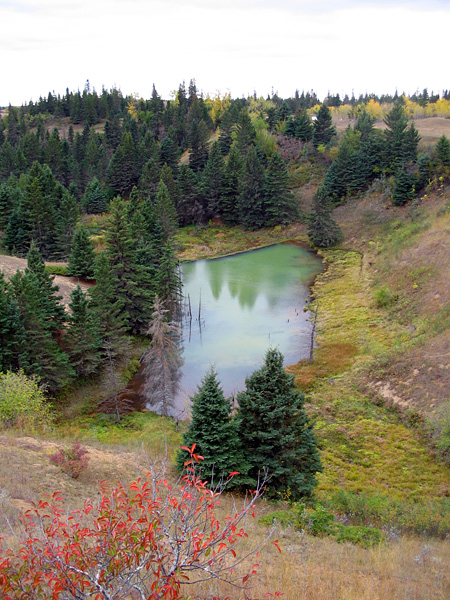Sand, Sand, and More Sand
Sand is not a subject I generally consider to be “riveting”, and after my recent post about Lake Winnipeg beaches I thought that I would have very little to say about this topic in the foreseeable future. Nonetheless, when I saw the Spirit Sands of the Carberry Sandhills in their muted fall colours last Friday, I knew that I would have to post a few photos.

Every patch of landscape carries hidden within itself a history, a tale of how it arrived at its current form. As geologists and geographers have examined landscapes around the world, it has been our task to open them up and reveal their once-secret pasts and meanings. This process of finding the hidden stories sometimes reminds me of playing with one of those jokey matryoshka dolls of Russian leaders. The current ones start with Dmitry Medvedev on the outside. He is opened to reveal Vladimir Putin, followed by a reverse-order series of communist leaders, and ending with the czar in the middle.
The story hidden inside the Carberry Sandhills, about two hours west of Winnipeg, is much less sinister, but is in its own way infinitely intriguing. As they have been explored during the past century and more, these low hills have told us about their distant past along the margin of the immense glacial Lake Agassiz. Thousands of years ago, as the continental glaciers were melting northward, this ice-dammed lake occupied much of southern Manitoba and North Dakota. At times, the lake covered the entire Red River plain. Its expansion to the west was blocked by the abrupt rise of the Manitoba Escarpment, and its waters lapped against the base of that line of hills.

Like its modern descendent, the ancestral Assiniboine River flowed eastward from the high plains of Saskatchewan. This river was very broad, its sediment-laden waters fed by melting glaciers. Where the sandhills now stand, the river water met the lake, and as its flow was halted it deposited its immense load of current-transported sediment. This formed a large river-mouth delta. Years passed, and the lake receded northward, leaving the sediment as sloping hills of open sand, shifted by the snow melt and shaped into dunes by westerly winds.

The area of open sand in the modern-day sandhills is not immense, but the sand is nonetheless utterly impressive!
Those young sand dunes probably had little vegetative cover. If you could have stood in the middle of those tens of square kilometres of windblown sediment on a hot summer day, this part of Manitoba would have felt a lot like Saudi Arabia. But over time the plants moved in, and most of the modern-day sandhills are covered by grasses, junipers, spruce, a surprising variety of wildflowers, and even a few cacti. In the historic past there was more open sand than there is today; it was kept open by prairie fires and large grazing native quadrupeds. Since both of these are considered as enemies by civilized agriculture, they have become scarce, and in their absence the plants take over.

Tumbleweed
The sandhills are home to a variety of animal life, including unusual forms such as skinks and hognose snakes. In a previous visit on a hot summer day, as we walked along the path from the Devil’s Punchbowl we came upon a hognose snake, which first hissed fiercely at us, and then when that didn’t work, played dead. In the summer the sand itself is alive with small creatures such as tunnel-web spiders, and the air above is patrolled by a particularly nasty and voracious species of horsefly.

At the Devil's Punchbowl, the flow of water from underlying springs has caused the sand to collapse.
On such summer days the sand radiates a fierce and unyielding heat, but it also attracts crowds of visitors. Today, on a beautiful but cool autumn day, our car was the only one in the parking lot at mid-morning. We saw very few animals other than red squirrels, chipmunks, and a solitary grouse, but there was plenty of evidence that others were around (and probably saw us). There were many deer tracks, a variety of scats, and in one area there were tracks that appeared to be those of a skunk.
Keita was walking freely off the leash, but when some substantial coyote tracks crossed the path we decided that it would be best for such a small terrier to stay closer to us. As I explained to her, her cousins might enjoy meeting her far more than she would enjoy meeting them!

© Graham Young, 2009
Steven Kukla has pointed out that the Geological Survey of Canada has an interesting report on sand deposits in the prairie provinces at:

A nice place to sense the presence of the Great Spirit “Kiche Manitou”.
Nice report from Geological Survey on sand hills/dunes (page 9 discusses Spirit Sands): http://gsc.nrcan.gc.ca/climate/sanddune/pdf/sanddune.pdf
A mellow slideshow with native music and of some educational value featuring Spirit Sands:
Part 1: http://www.youtube.com/watch?v=ntfZvUDVqhw
Part 2: http://www.youtube.com/watch?v=R2t0YLGTtGI
Thanks! I’ll add a link to that GSC report. I have to admit that I actually didn’t seek out many sources for this piece – we spent months working on an exhibit about the sandhills a few years back, so I mostly depended on memory.
Quote: “Sand is not a subject I generally consider to be ‘riveting’…”
Ooooo! Those would be fightin’ words to Michael Welland, http://throughthesandglass.typepad.com/, but I’ll bet he’d love your story (and the one on Lake Winnipeg’s sand)! Great photos–great blog!
A bit late (I only just found this), but yes, fightin’ words indeed! Thanks for the good story and illustrations – and thanks, Howard, for the comment!